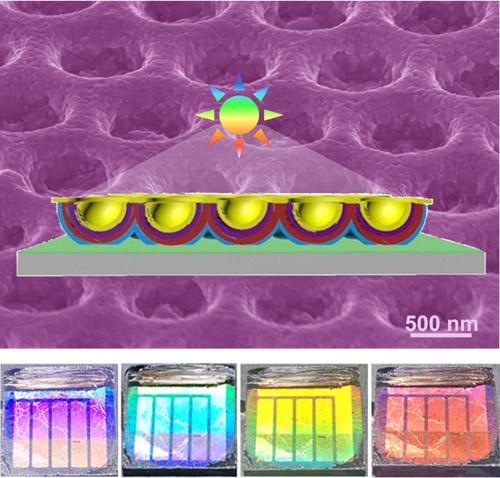
Credit: ©Science China Press
With the maturing of the perovskite solar cells (PSCs) technology, it is highly desirable to develop colorful solar cells to satisfy the requirements of aesthetic purposes in applications including building integrated photovoltaics and wearable electronics. The broad optical absorption and the large absorption coefficient of perovskites normally lead to high-efficiency cells with dark-brown colors. Till now, two representative approaches have been used to achieve colorful PSCs: (1) bandgap engineering and (2) structural colors. The former approach usually leads to considerably reduced power conversion efficiency (PCE) values (typically less than 13%) owing to diminished optical absorption associated with the enlarged bandgap. The latter approach takes advantage of engineered optical properties arising from patterned structures, enabling the generation of structural colors that are bright and dazzling. Despite the great efforts devoted to the colorful PSCs with respectable efficiencies, it remains a challenge to realize high-efficiency, colorful PSCs through deliberate structural design.
2D patterned nanobowl arrays with a remarkable photonic structure have been previously employed an electron transport layer (ETL) to fabricate efficient PSCs, but the obtained PSCs showed only dark or dark-brown colors, which could be related to the full filling of the nanobowls by the perovskite overlayer. Recently, Limin Qi’s research group in Peking University have developed a novel strategy to prepare colorful PSCs by delicate deposition of a uniform perovskite thin layer into arrayed NBs acting as a structured ETL without jeopardizing their photonic properties. They succeeded in using TiO2 NB arrays as a photonic ETL to integrate with a uniform thin overlayer of CH3NH3PbI3, achieving high-efficiency colorful perovskite solar cells. A new crystalline precursor film based on lead acetate was prepared through a Lewis acid base adduct approach, which allowed for uniform deposition of the precursor thin film onto the inner walls of the TiO2 NBs and subsequent formation of a uniform overlayer of high-quality perovskite crystals.
The perovskite solar cells fabricated using the nanobowl arrays inherited the photonic properties of the periodic structures, showing angle-dependent vivid colors under light illumination (Figure 1). These colorful PSCs exhibited a remarkable photovoltaic performance with a champion efficiency up to 16.94% and an average efficiency of 15.47%, which are higher than those for all the colorful PSCs reported so far. It is expected that the performance of the colorful PSCs based on the nanobowl arrays could be further improved by delicately manipulating the patterned nanoarray structure and optimizing the deposition processes of the perovskite films. This work may open a new avenue toward high-efficiency colorful perovskite solar cells with promising applications including building integrated photovoltaics.
###
This research was funded by the National Natural Science Foundation of China (21673007).
See the article: W. Wang, Y. He, L. Qi, “High-efficiency colorful perovskite solar cells using TiO2 nanobowl arrays as a structured electron transport layer” Sci. China. Mater. (2019) doi: 10.1007/s40843-019-9452-1
https:/
Media Contact
Limin Qi
[email protected]
Related Journal Article
http://dx.




